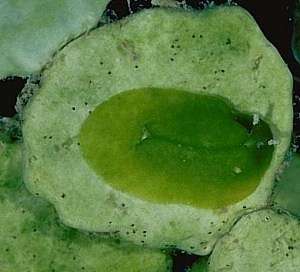
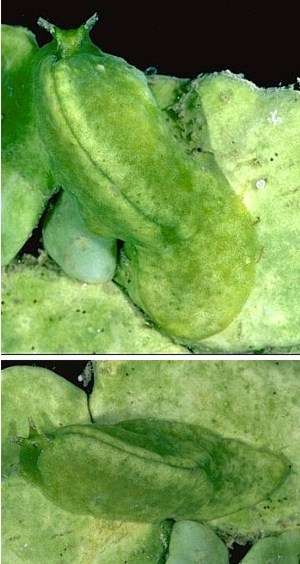
Elysiella pusilla
Bergh, 1872
Order: SACOGLOSSA
Superfamily: ELYSIOIDEA
Family: Elysiidae
DISTRIBUTION
Tropical Indo-West Pacific.
PHOTO
Koumac Beach (=Baie de Ouanap), near Koumac, New Caledonia, 20°34'S, 164°16'E, Mixed grassbeds and algae, on Halimeda. October 1993, 7 specimens (5-32mm long alive). UPPER: Small (7mm long) animal, normally found on bright green growing segment moved onto older, whiter, segment for photograph - it was invisible on the segment on which it was found. LOWER PHOTOS: Large (32mm long) specimens photographed in situ on older segments. PHOTOS: Bill Rudman.
This extremely cryptic elysioid is found exclusively on the calcareous green alga Halimeda. When living on Halimeda with broad flattened segments, the slugs are very flattened, especially the larger individuals, but on Halimeda with cylindrical segments, the animals match the cylindrical shape of the plant, as I have illustrated on a second page.
The flattened form is always well camouflaged, matching the colour of the part of the Halimeda plant on which it is living. Smaller specimens are usually a uniform bright green and are found on the smaller uniformly green growing segments of the plant. Larger animals, as illustrated here in the lower photos, can have the same mottled appearance as the larger more heavily calcified older segments of Halimeda. In many respects this species is just a modified species of Elysia, but because of the reduced parapodia, many workers today are following Bergh and placing it in the monotypic genus Elysiella.
Synonyms include Elysia dubia Eliot, 1904., Elysia halimedae Macnae, 1954., Elysia latipes Marcus & Marcus, 1960 & Elysia macnaei Marcus, 1982.
See Page 2 where cylindrical form of Elysiella pusilla is illustrated.
References:
• Bergh, L.S.R. (1872). Malacologische Untersuchungen. In: C.G. Semper, Reisen im Archipel der Philippinen, Wissenschaftliche Resultate. Band 2, Heft 3: 137-176, Pls. 17-20.
• Jensen, K.R. (1992). Anatomy of some Indo-Pacific Elysiidae (Opisthobranchia: Sacoglossa [=Ascoglossa]), with a discussion of the generic division and phylogeny. Mal. Soc. London, 58: 257-96
Authorship detailsRudman, W.B., 1999 (July 24) Elysiella pusilla Bergh, 1872. [In] Sea Slug Forum. Australian Museum, Sydney. Available from http://www.seaslugforum.net/find/elyspus1
Related messages
Elysiella pusilla from the Pacific coast of Mexico
December 1, 2009
From: Kevin Lee
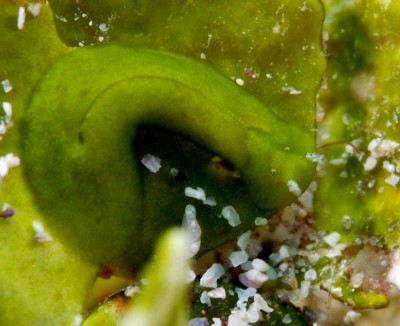
This past July, I had the great pleasure of 'branking' with Alicia Hermosillo, in Puerto Vallarta, Mexico. Ali's body & eyes should be registered as a national treasures, as she is able to locate slugs, small as a specks of sand or so well-camouflaged that mere mortals cannot see them.
One such slug, Elysiella pusilla, is presented here. When Ali "showed" it to me, I kept looking and looking, not knowing what it was. Finally, I had a Eureka moment and the animal registered in my brain.
Is this the same slug as the recently posted "Elysiella pusilla from Gulf of Kutch, India" [message #22859], I wonder?
Locality: Puerto Vallarta, 25 feet, Mexico, East Pacific, 05 July 2009, Rocky, sandy reef, with UW flora. Length: 1/2 inch. Photographer: Kevin Lee.
I'll share more cryptic characters, from Mexico, on the forum, which, but for Ali, I would have never seen.
Cheers,
K:-)
diverkevin@gmail.com
Lee, Kevin, 2009 (Dec 1) Elysiella pusilla from the Pacific coast of Mexico. [Message in] Sea Slug Forum. Australian Museum, Sydney. Available from http://www.seaslugforum.net/find/22899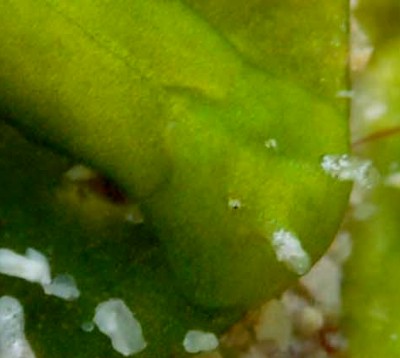
Dear Kevin,
I am sure diving with Ali must have been very rewarding experience. From India to Mexico is certainly a long way, but from all accounts it appears that the species does indeed range from east Africa to west Mexico.
Best wishes,
Bill Rudman
Elysiella pusilla from Gulf of Kutch, India
November 27, 2009
From: Vishal Bhave
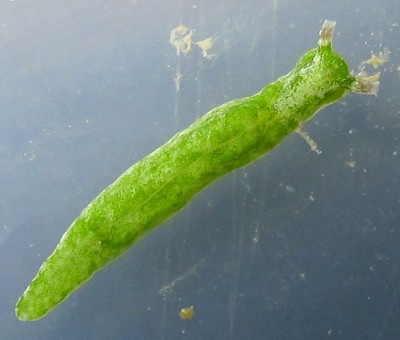
Concerning message #1121:
Dear Bill,
Those slugs were seen on Sargassum species and also on a species of Halimeda. In resting these look flattened. I doubt those are Elysiella pusilla ?
Locality: Okha, Gulf of Kutch, 10-40 cm, Gujarat, India, Arabian sea / Gulf of Kutch, Intertidal with lots of alga in small rock pools. Length: 12 mm. Photographer: Vishal Bhave.
Vishal Bhave
vishalbhave@gmaill.com
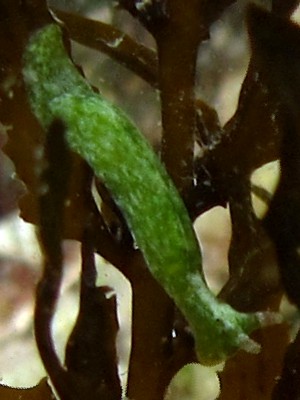
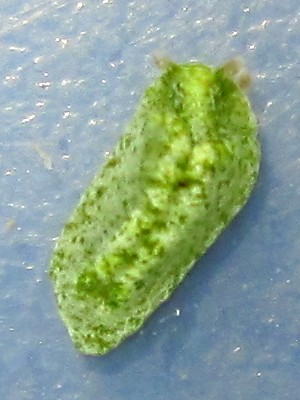
Dear Vishal,
I have no doubt your animals are Elysiella pusilla. There is no 'biological' reason why it should be crawling on Sargassum but at times in tidepools animals leave their favoured places and crawl out over brown algae which often forms a fringe aroud the edge. I have often found sponge feeding dorids doing the same, often just before the tide turns and the water starts to return. It may be something to do with an internal rhythm or maybe by the end of low tide the water temperature or oxygen levels are causing discomfort.
But to return to Elysiella pusilla. As I discuss on page 2 of the Fact Sheet, this species can change shape from a very flattened animal to a quite cylindrical form. Your photos show both these forms.
Best wishes,
Bill Rudman
Re: Feeding on Halimeda
June 30, 2003
From: Kathe R. Jensen
Dear Bill & Oliver,
In answer to Oliver's question about zigzag marks on Halimeda - In the Caribbean, Bosellia mimetica makes the zig-zag grazing marks on Halimeda. I can't remember if Elysiella does the same. Most of the specimens I have collected have been very small and so probably have not made much in the way of visible grazing marks. The teeth of Bosellia are short and broad and thus may only penetrate the superficial utricles of Halimeda. The teeth of Elysiella are relatively longer and more slender, so probably they can penetrate to the deeper utricles, which may mean that they can empty several interconnected superficial utricles at the same time.
Elysia serca, also a Caribbean species, which feeds on seagrasses, makes the same kind of zig-zag grazing marks. It shifts the head alternately to the left and right when feeding, so it does not penetrate into cells (seagrasses are real plants and have cells, not utricles), which have already been sucked dry.
Best wishes,
Kathe
krjensen@zmuc.ku.dk
Thanks Kathe,
Perhaps it would help Oliver if you could tell us where your Halimeda is from?
Best wishes
Bill Rudman
Feeding on Halimeda
June 27, 2003
From: Oliver A. Gussmann
Dear Dr. Rudman,
In my PhD research I have come across 'curious zig-zag grazing traces' on the living segments of the calcareous alga Halimeda. I have read that some nudibranchs feed on the alga's chloroplasts, and wondered if they would leave such (any) a grazing trace. Any comments would be helpful.
Sincerely,
Oliver Gussmann
Department of Marine Science
University of Otago
Dunedin, New Zealand
gusol423@student.otago.ac.nz
Gussmann, O.A., 2003 (Jun 27) Feeding on Halimeda. [Message in] Sea Slug Forum. Australian Museum, Sydney. Available from http://www.seaslugforum.net/find/10330Dear Oliver,
If you look at the Solar-powered Sea Slugs Page you'll get some information on sacoglossan [not nudibranch] feeders and their retention of chloroplasts.
A number of species do graze on species of Halimeda. In the Indo-West Pacific the most common species to do this is Elysiella pusilla [see Page 1, Page 2]. You can find other examples on the Forum by using the search facility to search for halimeda
As to grazing marks. Although I have often found them on Halimeda I can't recall seeing grazing marks. This may be related to the nature of their teeth - they have a ribbon consisting of a single tooth in each row. In those grazing molluscs that leave recognisable traces, the radula ribbon is quite broad, usually with multiple teeth in each row. This doesn't mean your grazing marks aren't caused by a sacoglossan, but I would say it is unlikely.
Best wishes
Bill
Elysiella pusilla from Kerama Is., Japan
August 3, 2001
From: Jun Imamoto

Dear Dr.Rudman
I went to Atsushi Ono's place Zamami, Kerama Ids, off Okinawa, Japan, from July 13, 2001 to July 17, 2001. We were able to observe about 80 kind of sea slugs.
I attach photos I took of some species of Elysia that were common there. I am happy if those are helpful for you.
Length: 12mm
Depth: 5-7M
Best Regards,
Jun Imamoto
imamoto@wips.co.jp
Imamoto, J., 2001 (Aug 3) Elysiella pusilla from Kerama Is., Japan. [Message in] Sea Slug Forum. Australian Museum, Sydney. Available from http://www.seaslugforum.net/find/4936Dear Jun,
I have split the photos up into separate messages. This one is Elysiella pusilla. It is usually found feeding on the calcified green alga Halimeda
Best wishes,
Bill Rudman.
Chemical defence in Elysiella pusilla
May 6, 2000
From: Bill Rudman
Here is the summary of an interesting paper (Paul, V.J. & van Alstyne, K.L.,1988) on the ability of Elysiella pusilla [as Elysia halimedae] to convert and use chemicals from its algal food for its own defence. This is a continuing theme throughout the sea slugs and that in itself is fascinating for it suggests that retaining chemicals for defensive purposes has evolved independently, many times amongst the opisthobranchs.
Sacoglossans are specialized herbivores of tropical green seaweeds and other seaweeds (diatoms, red algae, seagrasses). In this study, they investigated the feeding relationship between the sacoglossan Elysiella pusilla and its preferred food, the seaweed Halimeda macroloba Decaisne, in Guam. The toxic diterpenoid metabolites of many species of Halimeda have been shown to act as feeding deterrents toward nonspecialized grazers such as herbivorous fishes. However, E. pusilla feeds only on species of Halimeda and prefers young plant growth, which contains the highest concentrations of the Halimeda compounds. Their observations suggest that E. pusilla modifies the major diterpenoid from H. macroloba and sequesters and stores this modified compound for its own defense. When irritated, E. pusilla secretes large amounts of mucus containing this defensive compound. The compound occurs in E. pusilla as approximately 7% of the whole animal dry mass. Similar high concentrations of the compound are found in the egg masses of E. pusilla. In the study, they isolated and determined the structure of the sacoglossan compound and tested the compound in field assays on carnivorous and herbivorous fishes on Guam. This compound has a significant feeding deterrent effect at naturally occurring concentrations toward potential predators. Thus they show that E. pusilla is adapted to feed on toxic algae and utilizes the algal chemical defenses for its own defense against predation.
Reference:
Paul, V.J. & van Alstyne, K.L. (1988) Use of ingested algal diterpenoids by Elysiella halimedae Macnae (Opisthobranchia: Ascoglossa) as antipredator defenses. Journal of Experimental Marine Biology and Ecology, 119: 15-29.
Re: Elysiella pusilla
July 28, 1999
From: Eirik Eilertsen
Dear Bill,
The animal I've found looks much "taller" than the animals depicted in your forum, but I still think you got it right.
The algae, by the way, grew out of some live rock in my main tank about a year ago. I moved it to a "small critter tank" a few months ago, and I only recently discovered the slug. It was probably introduced with some red and green algae (including Halimeda) from Singapore, but it seems the old Halimeda is a much closer match than the new one, where both shape and color of the individual segments are concerned. Whenever I manage to spot it in the tank, I am amazed as to just how much it looks like the algae on which it clearly feeds. The color is an exact match (you don't mention anything about this species being able to change color) and the overall shape of the animal makes it virtually impossible to distinguish from the algae segments. The animal even has a distinct narrowing of the body just behind the head, giving the impression of two connected segments of Halimeda. Today I noticed that the color and overall texture of the animal seems different from when I first spotted it. It is now covered with tiny white appendages, which makes it look even more like the algae which is overgrown with other species of (micro) algae.
Eirik Mack Eilertsen
NORWEGIAN COLLEGE OF FISHERIES SCIENCE
UNIVERSITY OF TROMSOE,
NORWAY
eirike@stud.nfh.uit.no
Eilertsen, E.M. , 1999 (Jul 28) Re: Elysiella pusilla. [Message in] Sea Slug Forum. Australian Museum, Sydney. Available from http://www.seaslugforum.net/find/1121Dear Eirik,
For the Halimeda to stay alive so long in your tank, you obviously have a healthy aquarium system. If you look at the pictures on the second page you will see animals of Elysiella pusilla which have much more raised Elysia-like parapodia than the flattened animals on the first page.
Concerning them changing colour. Most sacoglossans get their colouration from their plant food. Only a very few have external skin pigmentation, of which Cyerce nigricans is a spectacular example. This means that the colour of most sacoglossans matches the food they are eating very precisely. I am not sure how they manage the mottled effect in large flattened E. pusilla, but it certainly matches the mottled white and green colour of the older segments of Halimeda, while smaller animals, with their uniform green colour, match the deeper colour of the young growing segments of the algae.
Interestingly, some animals on the more cylindrically-shaped variety of Halimeda have a colour pattern of whitish streaks.
I am puzzled by your mention of white papillae appearing on your animal. While the rhinophoral tentacles can have papillae I have never seen papillae on the rest of the body. Perhaps you should follow their progress and see if you can get a photo of the animal. It is always possible that you have a species of Elysia rather than Elysiella. My identification is based to a large extent on your animal being associated with Halimeda.
Best wishes,
Bill Rudman.
Halimeda sea slug
July 25, 1999
From: Eirik Mack Eilertsen

After stirring up a large cluster of Halimeda sp. in one of my saltwater tanks, I noticed what appeared to be a piece of Halimeda stuck on the front glass. On closer inspection it turned out to be a magnificently well camouflaged nudibranch.
It measured about 1" and was completely green except for a pair of small, white antennae.
It had some sort of ridge on the dorsal side, which seemed to be made up by the nudibranch folding its skin. Notice on the figure how the hollow ridge ends in two small openings, one in each end. It moved in a caterpillar-like fashion, now and then lifting its head and about half of its body from the substratum, as if to take a good look around. I have only a few times been able to spot it when its attached to the Halimeda macro algae in my tank. The dorsal ridge gives it the same kind of flattened appearance as the individual segments of the algae, its head making up a smaller segment with the antennae looking pretty exactely like new shoots.
Can you please help me identify this beautiful slug?
Thanks in advance!
Eirik
eirike@stud.nfh.uit.no
Eilertsen, E.M., 1999 (Jul 25) Halimeda sea slug. [Message in] Sea Slug Forum. Australian Museum, Sydney. Available from http://www.seaslugforum.net/find/1114Dear Eirik,
Do you know where the Halimeda came from, or is this like your earlier find of Tritoniopsis elegans, a lucky bonus from your aquarium shop?
From your drawings and detailed description I am pretty sure I can identify your animal as Elysiella pusilla. It is not actually a nudibranch, but it is an opisthobranch sea slug belonging in the ORDER Sacoglossa. If you have a look in the Species List at the names listed under Sacoglossa you will find the diversity and variety of shape in the sacoglossans is nearly equal to the nudibranchs, even if only a few are as brightly coloured. What is more remarkable is that all the sacoglossans are herbivores feeding by sucking cell sap from algae. Elysiella pusilla, like most sacoglossans is very specialised, feeding on only one or a small group of algae, in this case in the genus Halimeda. This genus of seaweeds are unusual because they have a calcareous outer skeleton. Because this makes the plant effectively rigid, it is broken into chains of jointed segments so that it can move in the currents without breaking.
The plant grows by adding new segments at the tip of each 'branch'. These new and growing segments are softer and more lightly calcified than the older segments, and Elysiella is usually found, well-camouflaged, on these younger segments. Interestingly, most new growth in Halimeda occurs at night, and at this time it concentrates toxic chemicals in these growing regions to deter predators. It doesn't seem to deter Elysiella.
Best wishes,
Bill Rudman.
